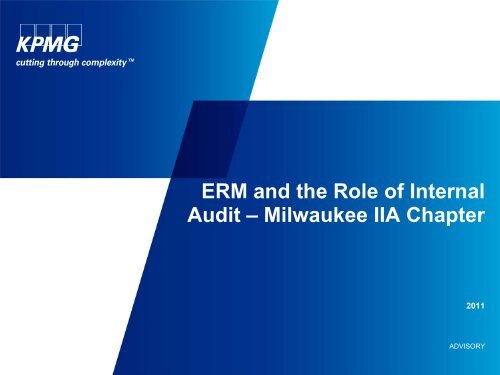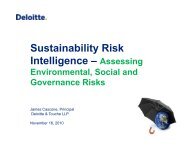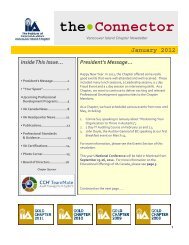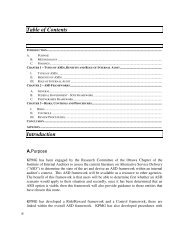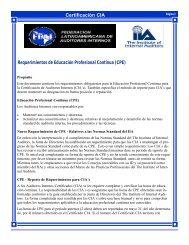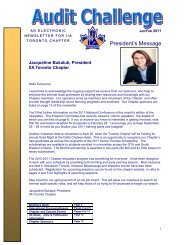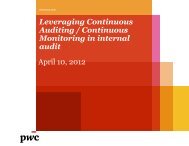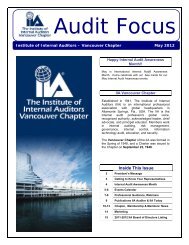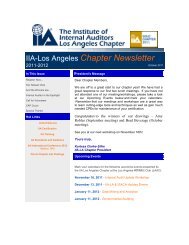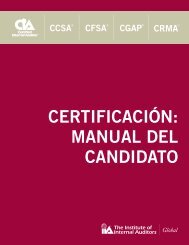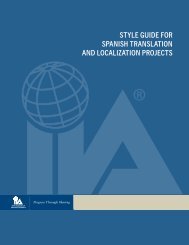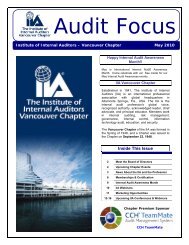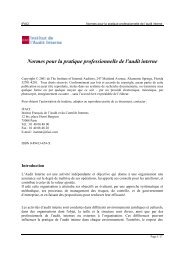Risk Management - The Institute of Internal Auditors
Risk Management - The Institute of Internal Auditors
Risk Management - The Institute of Internal Auditors
Create successful ePaper yourself
Turn your PDF publications into a flip-book with our unique Google optimized e-Paper software.
ERM and the Role <strong>of</strong> <strong>Internal</strong>Audit – Milwaukee IIA Chapter2011ADVISORY
Presentation Topics•Introduction•Evolution <strong>of</strong> <strong>Risk</strong> <strong>Management</strong>•Trends in <strong>Risk</strong> <strong>Management</strong>•ERM and <strong>Internal</strong> Audit© 2011 KPMG LLP, a Delaware limited liability partnership and the U.S. member firm <strong>of</strong> the KPMG network <strong>of</strong>independent member firms affiliated with KPMG International Cooperative (“KPMG International”), a Swiss entity.All rights reserved. <strong>The</strong> KPMG name, logo and “cutting through complexity” are registered trademarks or trademarks <strong>of</strong>KPMG International. 45469CHI1
Evolution <strong>of</strong> <strong>Risk</strong><strong>Management</strong>
<strong>The</strong> Evolution <strong>of</strong> <strong>Risk</strong> <strong>Management</strong>BasicRemain in ComplianceMatureA <strong>Management</strong> ProcessAdvancedA Strategic ToolERA• People• IA and Audit Committee• IA:− Financial− Compliance• ProcessERM• Exec <strong>Management</strong>• Alignment to Strategy/Ops• <strong>Risk</strong> <strong>Management</strong>Discipline• Enterprise-wideGRC• Technology• All Levels <strong>of</strong>Organization• Single Source <strong>of</strong> Truth• Convergence• Test Once – SatisfyMany© 2011 KPMG LLP, a Delaware limited liability partnership and the U.S. member firm <strong>of</strong> the KPMG network <strong>of</strong>independent member firms affiliated with KPMG International Cooperative (“KPMG International”), a Swiss entity.All rights reserved. <strong>The</strong> KPMG name, logo and “cutting through complexity” are registered trademarks or trademarks <strong>of</strong>KPMG International. 45469CHI3
Enterprise <strong>Risk</strong> AssessmentBasicRemain in ComplianceERA• People• IA and Audit Committee• IA:− Financial− Compliance© 2011 KPMG LLP, a Delaware limited liability partnership and the U.S. member firm <strong>of</strong> the KPMG network <strong>of</strong>independent member firms affiliated with KPMG International Cooperative (“KPMG International”), a Swiss entity.All rights reserved. <strong>The</strong> KPMG name, logo and “cutting through complexity” are registered trademarks or trademarks <strong>of</strong>KPMG International. 45469CHI4
Enterprise <strong>Risk</strong> Assessment (ERA)Creating ContentPrimaryActivitiesResources(Team toExecute)• Develop project plan andtimeline• Identify process enablingtools, templates, etc.• Confirm ERA approach,timing, expectations, anddeliverables with ProjectSponsor• Finalize participant list• Communicate project plan toparticipants• Identify client specific areas<strong>of</strong> focus (e.g. IT)• Identify information requeststo clientDeliverables • Project plan and timeline,including priority sequencedprocess steps• Identified tools and templatesportfolio• Customized ERA ProcessOverview• Participant List• Kick<strong>of</strong>f Communication• Information Request ListExampleTimelineProject PlanPlan Interviews• Develop interview template toensure consistency• Anticipate key business riskportfolio & sources• Develop preliminary keybusiness risk templates• Schedule interviews andfacilitated session(s)• Develop and share participantpre-read document• Interview preparation− Assess need for SubjectMatter Pr<strong>of</strong>essional(s)(SMP)Client• Project Sponsor and/or their designee(s)• Scheduling and Logistics CoordinatorKPMG• Partner• Director/Manager• Senior Associate• Others as needed, including SMP(s)• Interview template• Key Business <strong>Risk</strong> (KBR):− Portfolio (BRP)− Sourcing Matrix− Definitions• Interview and facilitationschedule• Interviewee pre-readdocument• Interviewee-specific clientprovided informationWeek 1 Week 1Conduct InterviewsEvaluateValidateERA Deliverable, including:• Identify primary risk-taking • Update:Conduct facilitated session toactivities− BRPenable collaborative consensus• Identify key risks, sources & − <strong>Risk</strong> Assessmenton:examplesTemplates• Portfolio view <strong>of</strong> risk• Discuss risk appetite/− Sourcing Matrix− KBR portfolioboundaries (empowerment) − Monitor/Report• KBR Assessment Templates• Identify intra/interdependencies• Customize voting criteria • <strong>Risk</strong> rankings• Portfolio view <strong>of</strong> risk:• <strong>Risk</strong> management capabilities• Discuss key risk management − KBRs• Priority action stepscapabilities (P, P, T)− Radar Screen• Discuss risk monitoring and− Watch Listreporting process• Identify “top-down” vs.• Summarize & confirm key“bottom-up” gapsinterview findings with• Finalize facilitated sessionintervieweeplan• Confirm next steps• Distribute pre-readClient• Project Sponsor and/or their designee(s)• Designated participants• Note Taker/AggregatorKPMG• Partner and Director or Manager• Facilitator• Others as needed, including SMP(s)• Interview summaries • Facilitated session pre-read• Populated ResolverBallot TM • Launch ERM Journeydocument• Business <strong>Risk</strong> Portfolio− Sourcing Matrix• <strong>Risk</strong> Assessment Templates− BRP• Updated Sourcing Matrix− <strong>Risk</strong> Assessment• Heat mapTemplate• “Top-down” and “bottom-up”− Voting CriteriaGap Assessment− Priority action steps− Accountability− ResourcesWeeks 2 – 4Weeks 4 – 5 Week 5 +© 2011 KPMG LLP, a Delaware limited liability partnership and the U.S. member firm <strong>of</strong> the KPMG network <strong>of</strong>independent member firms affiliated with KPMG International Cooperative (“KPMG International”), a Swiss entity.All rights reserved. <strong>The</strong> KPMG name, logo and “cutting through complexity” are registered trademarks or trademarks <strong>of</strong>KPMG International. 45469CHI5
<strong>Risk</strong> Portfolio ExampleEXTERNAL RISKS• Capital Availability• Competitor• Customer Needs• Economy• Financial Markets• Industry• Legal• Natural Hazard/Catastrophe• Public Relations• Regulatory• Sovereign/Political• Technological Innovation• TerrorismINTERNAL RISKSStrategic Operational Financial• Business ModelProcess• Collateral• Business Portfolio• Delivery Channels• Intellectual Property• Marketing/Advertising• Marketplace• Alignment• Business Interruption• Capacity• Change Response• Compliance• Contract Commitment• Customer Satisfaction• Cycle Time• Efficiency• Environmental• Health & Safety• Knowledge<strong>Management</strong>• Measurement• Partnering• Physical Security• Product/ServiceDevelopment• Product/Service Liability• Product/Service Failure• Product/Service Pricing• Relationship <strong>Management</strong>• Sourcing• StrategyImplementation• Supply Chain• TransactionProcessing• Commodities• Concentration• Counterparty• Credit• Default• Organization Structure<strong>Management</strong> InformationHuman CapitalIntegrityTechnology• Equity• Planning• Product Life Cycle• Resource Allocation• Social Responsibility• Accounting Information• Budgeting & Forecasting• Completeness/Accuracy• Investment Evaluation• Investor Relations• Pension Fund• Regulatory Reporting• Relevance• Taxation• Accountability• Change Readiness• Communications• Competencies/Skills• Empowerment• Hiring/Retention• Leadership• Outsourcing• Performance Incentives• Succession Planning• Training/Development• Conflict <strong>of</strong> Interest• Employee Fraud• Ethical Decision-making• Illegal Acts• <strong>Management</strong> Fraud• Third-Party Fraud• Unauthorized Acts• Access• Availability• Data Integrity• e-Commerce• Infrastructure• Reliability• TechnologicalCapacity• Financial Instruments• Foreign Exchange• Interest Rate• Liquidity• Modeling• Opportunity Cost© 2011 KPMG LLP, a Delaware limited liability partnership and the U.S. member firm <strong>of</strong> the KPMG network <strong>of</strong>independent member firms affiliated with KPMG International Cooperative (“KPMG International”), a Swiss entity.All rights reserved. <strong>The</strong> KPMG name, logo and “cutting through complexity” are registered trademarks or trademarks <strong>of</strong>KPMG International. 45469CHI6
Common Language:Compliance <strong>Risk</strong> ExampleDefinition<strong>The</strong> risk that a flaw in process design or operation, human error, oversight or indifference canresult in failure to conform with laws and regulations at the country, state and local level.Company representatives, including Board members, management, employees or third-partiesunder the “control and supervision” <strong>of</strong> the Company, do not comply with prescribed proceduresand policies.Company SourceInternationalContracts & PricingSuppliers/VendorsOther SBUs/BUs<strong>Risk</strong> Events• Compliance with applicable Domestic and International regulations are not followed timely• Compliance with environmental regulations are not followed timely• Non-compliance with SOX regulations can lead to a loss in investor confidence• Employees don’t fully understand and/or misinterpret periodic training contentExample <strong>Risk</strong> Mitigation Techniques• Periodic training and testing employee pr<strong>of</strong>iciency and understanding• Periodic/continuous monitoring <strong>of</strong> various internal databases and information flows• Periodic, at least annual, employee/vendor affirmation <strong>of</strong> compliance• “Whistle-blower” Hot Line© 2011 KPMG LLP, a Delaware limited liability partnership and the U.S. member firm <strong>of</strong> the KPMG network <strong>of</strong>independent member firms affiliated with KPMG International Cooperative (“KPMG International”), a Swiss entity.All rights reserved. <strong>The</strong> KPMG name, logo and “cutting through complexity” are registered trademarks or trademarks <strong>of</strong>KPMG International. 45469CHI7
Ranking Criteria:Impact ExampleWhat is the event impact / consequence to the business? Residual vs. Inherent?5 Catastrophic4 Major3 Significant2 Minor1 InsignificantQuantitatively• Revenue• EPS/Pr<strong>of</strong>itability• Cash Flow• Debt Covenants• Capital Value• Investment PortfolioQualitatively• Reputation/Brand• Customer Satisfaction/Service• Level <strong>of</strong> Leadership Involvement• Key Alliances• Customer Retention• Employee Turnover• Market Share• Regulatory Licensing© 2011 KPMG LLP, a Delaware limited liability partnership and the U.S. member firm <strong>of</strong> the KPMG network <strong>of</strong>independent member firms affiliated with KPMG International Cooperative (“KPMG International”), a Swiss entity.All rights reserved. <strong>The</strong> KPMG name, logo and “cutting through complexity” are registered trademarks or trademarks <strong>of</strong>KPMG International. 45469CHI8
Ranking Criteria:Likelihood ExampleWhat is the likelihood / frequency <strong>of</strong> occurrence for key risks? Residual vs. Inherent?5 Almost Certain4 Likely3 Moderate2 Unlikely1 RareEvent will occur in most circumstances, 90% or more <strong>of</strong> the time (e.g.snow in Minnesota in Jan and Feb)Event should occur, more than 50% probability and up to 90% certainty(e.g. snow in Minnesota in Dec)Event will probably occur, more than 25% and up to 50% probability (e.g.snow in Minnesota in Nov)Event could occur; more than 5% up to 25% probability(e.g. snow in Minnesota in Oct)Event would occur only in exceptional circumstances; < 5% probability(e.g. snow in Minnesota in May)© 2011 KPMG LLP, a Delaware limited liability partnership and the U.S. member firm <strong>of</strong> the KPMG network <strong>of</strong>independent member firms affiliated with KPMG International Cooperative (“KPMG International”), a Swiss entity.All rights reserved. <strong>The</strong> KPMG name, logo and “cutting through complexity” are registered trademarks or trademarks <strong>of</strong>KPMG International. 45469CHI9
Ranking Criteria:<strong>Management</strong> Effectiveness ExampleDo we have the right level <strong>of</strong> the right risk management capabilities?People Process Technology5 OptimizedProcessReliantProactiveShort &Long-TermTechnologyAlignedRight Skills/Cross Train4 Managed3 Defined2 Repeatable1 InitialPeople ReliantReactiveShort-TermLittle TechnologyLack Skills<strong>Management</strong>© 2011 KPMG LLP, a Delaware limited liability partnership and the U.S. member firm <strong>of</strong> the KPMG network <strong>of</strong>independent member firms affiliated with KPMG International Cooperative (“KPMG International”), a Swiss entity.All rights reserved. <strong>The</strong> KPMG name, logo and “cutting through complexity” are registered trademarks or trademarks <strong>of</strong>KPMG International. 45469CHI10
Mature ERA:<strong>Management</strong> Effectiveness Bubble DiagramLikelihood5.004.504.003.503.002.50Conflict <strong>of</strong>InterestCurrencyCapital MarketsData IntegrityData PrivacyBudget /ForecastData AnalyticsSystem Reliability andKnowledge Retention AvailabilityCommunicationsRetirement ObligationsIT CapacityContract CommitmentsInformationSecurityFinancial /RegulatoryReportingEnvironment, Health andSafetyCommodities /DerivativesIntegrityand FraudLegendMgmt Gap≥ 22 < MgmtGap ≤ 1Mgmt Gap< 12.001.50Legal / RegulatoryPublic / Investor RelationsComplianceNatural Hazard /CatastropheInvestments LiquidityTaxation1.001.00 1.50 2.00 2.50 3.00 3.50 4.00 4.50 5.00Impact© 2011 KPMG LLP, a Delaware limited liability partnership and the U.S. member firm <strong>of</strong> the KPMG network <strong>of</strong>independent member firms affiliated with KPMG International Cooperative (“KPMG International”), a Swiss entity.All rights reserved. <strong>The</strong> KPMG name, logo and “cutting through complexity” are registered trademarks or trademarks <strong>of</strong>KPMG International. 45469CHI11
Enterprise <strong>Risk</strong> AssessmentMaturity ModelEnterprise <strong>Risk</strong> Assessment Maturity ModelBasic Mature AdvancedVision/Strategy <strong>Internal</strong> Audit – Stand Alone Enterprise-wide Sharing/Communication Integrated GRC Process and ToolApproach Existing Data Interviews/Surveys/Self Assessment Collaboration/FacilitationApproach ElementsReporting CFO & Audit Committee Exec Mgmt & Entire Board Operational <strong>Management</strong> & Key Ops Functions<strong>Risk</strong> Ranking Impact & Likelihood Velocity <strong>Management</strong> EffectivenessCommunication Annual Audit Plan Proactively Sharing With Standard Setters Operationalizing & Mgmt Action ItemsQuality <strong>Internal</strong> Audit Process <strong>Risk</strong> Committee/Business Leader Review Third-party ReviewCollaboration <strong>Internal</strong> Audit View Only Facilitated Sessions External Subject Matter Pr<strong>of</strong>essionalsAlignment <strong>Internal</strong> Audit Strategy Enterprise Strategy Converged <strong>Risk</strong> <strong>Management</strong> FunctionValue to Business Finance/Compliance Operational/Traditional Proactive/Innovation/OpportunitiesEmerging <strong>Risk</strong>s Ad Hoc Identification <strong>Internal</strong> Identification <strong>Internal</strong> and External IdentificationCustomer Focus Audit Committee/CFO Entire Board/CEO Shareholders/OwnersScenarios/Interconnections Enterprise <strong>Risk</strong> Portfolio – <strong>Risk</strong> Listing Key Business <strong>Risk</strong> Scenarios Entire Enterprise <strong>Risk</strong> Portfolio ScenariosBusiness <strong>Risk</strong> Portfolio Audit Plan – <strong>Internal</strong> Audit Enterprise <strong>Risk</strong> Portfolio – Strategic Alignment Emerging <strong>Risk</strong> – Proactive IdentificationQuantification/History Sample Testing Process Design/Analysis/Testing Continuous Monitoring & AuditingExisting Inputs/Data <strong>Internal</strong> Audit Information Standard Setters – Business <strong>Risk</strong> Assessments External & Real-time <strong>Internal</strong>Frequency Annual Periodic ContinuousTools Spreadsheets and Word Trending/Analysis/Facilitation GRC Tool Based On Process RequirementsInterview Layers <strong>Internal</strong> Audit Executive <strong>Management</strong> BOD, External Pr<strong>of</strong>essionals, Operations© 2011 KPMG LLP, a Delaware limited liability partnership and the U.S. member firm <strong>of</strong> the KPMG network <strong>of</strong>independent member firms affiliated with KPMG International Cooperative (“KPMG International”), a Swiss entity.All rights reserved. <strong>The</strong> KPMG name, logo and “cutting through complexity” are registered trademarks or trademarks <strong>of</strong>KPMG International. 45469CHI12
Enterprise <strong>Risk</strong> <strong>Management</strong>MatureA <strong>Management</strong> Process• ProcessERM• Exec <strong>Management</strong>• Alignment to Strategy/Ops• <strong>Risk</strong> <strong>Management</strong>Discipline• Enterprise-wide© 2011 KPMG LLP, a Delaware limited liability partnership and the U.S. member firm <strong>of</strong> the KPMG network <strong>of</strong>independent member firms affiliated with KPMG International Cooperative (“KPMG International”), a Swiss entity.All rights reserved. <strong>The</strong> KPMG name, logo and “cutting through complexity” are registered trademarks or trademarks <strong>of</strong>KPMG International. 45469CHI13
Enterprise <strong>Risk</strong> <strong>Management</strong> Defined“Enterprise <strong>Risk</strong> <strong>Management</strong> is• A process,• Effected by an entity’s board <strong>of</strong> directors,management and other personnel,• Applied in strategy setting and across theenterprise,• Designed to identify potential events that mayaffect the entity,• Manage risks to be within its risk appetite, and• To provide reasonable assurance regarding theachievement <strong>of</strong> entity objectives.”Source: COSO Enterprise <strong>Risk</strong> <strong>Management</strong> – Integrated Framework (September 2004)© 2011 KPMG LLP, a Delaware limited liability partnership and the U.S. member firm <strong>of</strong> the KPMG network <strong>of</strong>independent member firms affiliated with KPMG International Cooperative (“KPMG International”), a Swiss entity.All rights reserved. <strong>The</strong> KPMG name, logo and “cutting through complexity” are registered trademarks or trademarks <strong>of</strong>KPMG International. 45469CHI14
Enterprise <strong>Risk</strong> <strong>Management</strong>: Importance <strong>of</strong> FundamentalsKPMG’s ERM FrameworkCatastrophic6FrameworkElementDescriptionMajor135<strong>Risk</strong>GovernanceEstablishment <strong>of</strong> approach for developing,supporting, and embedding the risk strategyand accountabilitiesConsequenceModerateMinor1012713 151491684<strong>Risk</strong>Assessment<strong>Risk</strong>Quantificationand AggregationIdentifying, assessing, and categorizing risksacross the enterpriseMeasurement, analysis, and consolidation <strong>of</strong>enterprise risksInsignificant1711Remote Unlikely Possible Likely Almost certain<strong>Risk</strong> Monitoringand ReportingReporting, monitoring, and assurance activitiesto provide insights into risk managementstrengths and weaknessesLikelihood<strong>Risk</strong> andControlOptimizationUsing risk and control information to improveperformanceCreating ContentIdentifying, evaluating andprioritizing enterprise risksCreating ProcessBuilding and maintaining a dynamic riskmanagement framework and process to achievesustainability© 2011 KPMG LLP, a Delaware limited liability partnership and the U.S. member firm <strong>of</strong> the KPMG network <strong>of</strong>independent member firms affiliated with KPMG International Cooperative (“KPMG International”), a Swiss entity.All rights reserved. <strong>The</strong> KPMG name, logo and “cutting through complexity” are registered trademarks or trademarks <strong>of</strong>KPMG International. 45469CHI15
<strong>Risk</strong> <strong>Management</strong> Structure and GovernanceThree Lines <strong>of</strong> Defense<strong>Risk</strong> GovernanceAssuranceProviders3 rdLINE OFDEFENSERISK PROCESS AND CONTENT Monitoring• Liaise with senior management and/or board• Rationalize and systematize risk assessment and governance reporting• Provide oversight on risk-management content/processes, followed bysecond line <strong>of</strong> defense (as practical)• Provide assurance that risk-management processes are adequate andappropriateAssuranceProvidersStandardSetters2 ndLINE OFDEFENSERISK PROCESS Accountability• Establish policy and process for risk management• Strategic link for the enterprise in terms <strong>of</strong> risk• Provide guidance and coordination among all constituencies• Identify enterprise trends, synergies, and opportunities for change• Initiate change, integration, operationalization <strong>of</strong> new events• Liaison between third line <strong>of</strong> defense and first line <strong>of</strong> defense• Oversight over certain risk areas (e.g., credit, market) and in terms <strong>of</strong>certain enterprise objectives (e.g., compliance with regulation)StandardSettersBusinessOwners1 stLINE OFDEFENSERISK CONTENT Accountability• Manage risks/implement actions to manage and treat risk• Comply with risk-management process• Implement risk-management processes where applicable• Execute risk assessments and identify emerging riskBusinessOwners© 2011 KPMG LLP, a Delaware limited liability partnership and the U.S. member firm <strong>of</strong> the KPMG network <strong>of</strong>independent member firms affiliated with KPMG International Cooperative (“KPMG International”), a Swiss entity.All rights reserved. <strong>The</strong> KPMG name, logo and “cutting through complexity” are registered trademarks or trademarks <strong>of</strong>KPMG International. 45469CHI16
Second Line <strong>of</strong> DefenseKeys to <strong>Risk</strong> <strong>Management</strong> EvolutionStandard Setters / <strong>Risk</strong> <strong>Management</strong>• Establish policy and process for riskmanagement• Strategic link for the enterprise in terms<strong>of</strong> risk• Provide guidance and coordinationamong constituencies• Identify enterprise trends, synergies andopportunities for change• Initiate change, integration andoperationalize new events• Liaison between third line <strong>of</strong> defenseand first line <strong>of</strong> defense• Oversight over key risk areas (e.g.,credit) necessary to meet enterpriseobjectives (e.g., compliance)<strong>Risk</strong> <strong>Management</strong> LeaderStandard Setters2 nd Line <strong>of</strong> Defense<strong>Management</strong> Validation© 2011 KPMG LLP, a Delaware limited liability partnership and the U.S. member firm <strong>of</strong> the KPMG network <strong>of</strong>independent member firms affiliated with KPMG International Cooperative (“KPMG International”), a Swiss entity.All rights reserved. <strong>The</strong> KPMG name, logo and “cutting through complexity” are registered trademarks or trademarks <strong>of</strong>KPMG International. 45469CHI17
<strong>Risk</strong> DisciplineInherent <strong>Risk</strong><strong>The</strong> intrinsic risk thecompany takes inoperating its business inthe absence <strong>of</strong> actionsmanagement might take tocontrol risk<strong>Risk</strong> Appetite & Tolerance<strong>Risk</strong> AppetiteMaximum amount <strong>of</strong> riskmanagement is willing to acceptto achieve strategic goals/objectives+<strong>Risk</strong> Tolerance=<strong>The</strong> range/variability<strong>of</strong> risk managementis willing to accept toachieve strategic goals/Objectives<strong>Risk</strong> <strong>Management</strong>Too Much <strong>Risk</strong>-TakingAcceptable <strong>Risk</strong> Taking:• Key <strong>Risk</strong> Indicators• Trend Analysis• Business DecisionsInsufficient <strong>Risk</strong>-Taking© 2011 KPMG LLP, a Delaware limited liability partnership and the U.S. member firm <strong>of</strong> the KPMG network <strong>of</strong>independent member firms affiliated with KPMG International Cooperative (“KPMG International”), a Swiss entity.All rights reserved. <strong>The</strong> KPMG name, logo and “cutting through complexity” are registered trademarks or trademarks <strong>of</strong>KPMG International. 45469CHI18
ERM Scorecard for Key Business <strong>Risk</strong>sPeople/Culture: Change <strong>Management</strong><strong>Risk</strong> Definition:Change <strong>Management</strong> – Failure to effectively manage change, understand employee’s resistance and capacity to accept and embrace it.Example Subrisks:• Competing priorities• #2Accountability:Mgmt Committee –Executive –<strong>Management</strong> –• #3• #4• #5Specific Examples:• Competing/conflicting priorities• Goals not aligned with strategy• Skills needed for cost management vs.growth• IT changes to support growth andregulatory requirements• Lack <strong>of</strong> sequencing/prioritizing initiatives• Communication <strong>of</strong> priorities• Uncertainty• #6• #7• #8<strong>Risk</strong> Direction:<strong>Risk</strong> Velocity:FastStrategy Links:InnovationQuality &SafetyGrowthSlowPartnershipsIMPACTCatastrophicMajorSignificantMinorInsignificantCurrent StateWeakResidual <strong>Risk</strong> –DesiredLIKELIHOODControl Effectiveness Ratings:StrongResidual <strong>Risk</strong> –CurrentRare Unlikely Moderate Likely AlmostCertain3Desired StateWeakStrongPotential Impacts:• $$Current <strong>Risk</strong> Mitigation Activities:• #1Key Mitigation Action Items(Owner/Due):• #1© 2011 KPMG LLP, a Delaware limited liability partnership and the U.S. member firm <strong>of</strong> the KPMG network <strong>of</strong>independent member firms affiliated with KPMG International Cooperative (“KPMG International”), a Swiss entity.All rights reserved. <strong>The</strong> KPMG name, logo and “cutting through complexity” are registered trademarks or trademarks <strong>of</strong>KPMG International. 45469CHI19
<strong>Management</strong> Effectiveness:Immediate Business Action Items5.0100%4.54.01.382.19 1.501.752.44 2.19 1.38 1.95 1.63 2.06 2.00 2.001.44 1.19 1.8190%80%3.570%3.02.5CurrentDesired60%2.01.51.050%40%30%MarketFinancialExternalGovernanceCredit <strong>Risk</strong>StrategicHuman CapitalProcess / Transaction0.50.020%10%0%Differences in <strong>Risk</strong> Mix by Business Areas© 2011 KPMG LLP, a Delaware limited liability partnership and the U.S. member firm <strong>of</strong> the KPMG network <strong>of</strong>independent member firms affiliated with KPMG International Cooperative (“KPMG International”), a Swiss entity.All rights reserved. <strong>The</strong> KPMG name, logo and “cutting through complexity” are registered trademarks or trademarks <strong>of</strong>KPMG International. 45469CHI20
<strong>Management</strong> Effectiveness:Example Segmentation for <strong>Internal</strong> Audit and <strong>Management</strong><strong>Risk</strong> Segmentation – Detailed <strong>Risk</strong> Segmentation Based on <strong>Management</strong> VotingKey <strong>Risk</strong> Impact LikelihoodLikelihood xImpact Mgmt Effect SegmentationChange Readiness 4.13 4.63 19.12 2.19 <strong>Management</strong> Improvement NeededChange Response 4.13 4.56 18.81 2.44 <strong>Management</strong> Improvement NeededCustomer Satisfaction 3.69 4.40 16.23 2.00 <strong>Management</strong> Improvement NeededResource Allocation 3.81 4.38 16.68 2.06 <strong>Management</strong> Improvement NeededOrganizational Structure and Purpose 3.73 4.33 16.17 2.00 <strong>Management</strong> Improvement NeededCompetition 4.19 4.13 17.27 2.19 <strong>Management</strong> Improvement NeededEconomy 4.20 4.88 20.48 1.38 Requires Independent ValidationMarketplace 3.88 4.87 18.86 1.50 Requires Independent ValidationCapital Availability 4.06 4.31 17.50 1.38 Requires Independent ValidationBusiness Model 4.06 4.31 17.47 1.95 Requires Independent ValidationRegulatory 3.56 4.07 14.49 1.19 Requires Independent ValidationAlignment to Strategy 3.75 4.06 15.23 1.75 Requires Independent ValidationFinancial Instruments 4.19 3.94 16.49 1.63 Requires Independent ValidationProduct/Service Pricing 3.75 3.81 14.30 1.81 Requires Independent ValidationCapacity 3.27 4.47 14.59 1.44 Watch ListAfter each business risk is analyzed, a scale can be used to segment the prioritized risks intohighly impactful areas ready for independent validation and where management improvements arenecessary© 2011 KPMG LLP, a Delaware limited liability partnership and the U.S. member firm <strong>of</strong> the KPMG network <strong>of</strong>independent member firms affiliated with KPMG International Cooperative (“KPMG International”), a Swiss entity.All rights reserved. <strong>The</strong> KPMG name, logo and “cutting through complexity” are registered trademarks or trademarks <strong>of</strong>KPMG International. 45469CHI21
Enterprise <strong>Risk</strong> <strong>Management</strong>Maturity ModelFrameworkElementBasicRemain in ComplianceMatureA <strong>Management</strong> ProcessAdvancedA Strategic Tool<strong>Risk</strong> GovernanceA central risk managementpolicy to support externalrequirementsA risk management structurewith clear accountabilities tosupport risk managementobjectivesI<strong>Risk</strong> management accountabilityintegrated with performancemanagement<strong>Risk</strong> AssessmentAnnual risk assessment withlimited analysis andinterpretationFrequent risk assessment in linewith normal managementreporting and including analysis<strong>Risk</strong> and control activitiesembedded in businessprocessesI<strong>Risk</strong> Quantificationand AggregationQuantification <strong>of</strong> selected risksQuantification <strong>of</strong> operationalrisk; advanced quantification <strong>of</strong>selected riskEntity – wide aggregation acrossall risk areasI<strong>Risk</strong> Monitoring andReportingBusiness risk reporting designedto support external requirementsExtensive reporting to the boardand audit committee on currentrisk levels and future risk issuesAlignment <strong>of</strong> all risk reporting toprovide a comprehensive singleview or riskI<strong>Risk</strong> and ControlOptimizationFewer surprises throughmanagement <strong>of</strong> key risksGreater stakeholder confidenceand improved risk mitigationstrategies<strong>Risk</strong> – adjusted strategy,performance evaluation, andcapital allocationII Industry State C Current State L Leading PracticeD Desired State S Stakeholder Expectations© 2011 KPMG LLP, a Delaware limited liability partnership and the U.S. member firm <strong>of</strong> the KPMG network <strong>of</strong>independent member firms affiliated with KPMG International Cooperative (“KPMG International”), a Swiss entity.All rights reserved. <strong>The</strong> KPMG name, logo and “cutting through complexity” are registered trademarks or trademarks <strong>of</strong>KPMG International. 45469CHI22
Governance, <strong>Risk</strong> and ComplianceAdvancedA Strategic ToolGRC• Technology• All Levels <strong>of</strong>Organization• Single Source <strong>of</strong> Truth• Convergence• Test Once – SatisfyMany© 2011 KPMG LLP, a Delaware limited liability partnership and the U.S. member firm <strong>of</strong> the KPMG network <strong>of</strong>independent member firms affiliated with KPMG International Cooperative (“KPMG International”), a Swiss entity.All rights reserved. <strong>The</strong> KPMG name, logo and “cutting through complexity” are registered trademarks or trademarks <strong>of</strong>KPMG International. 45469CHI23
<strong>Risk</strong> <strong>Management</strong>:Performance Comments from ClientsTiming and quality <strong>of</strong>information flow up to seniormanagementSiloed approach togovernance, riskmanagement andcomplianceInformation overload and inefficientbusiness steering and decision making(No common language <strong>of</strong> risk)Senor management's rolein understanding andanalysing emerging risksSurprisesImplementation focuses onhard (operational) controls,not on hearts and minds<strong>Risk</strong> and controls arenot embedded inbusiness activitiesFocus on financialcontrols instead <strong>of</strong>business controlsFalse comfort andunreliable information(form over substance)Costly and inefficient execution <strong>of</strong>multiple compliance activities© 2011 KPMG LLP, a Delaware limited liability partnership and the U.S. member firm <strong>of</strong> the KPMG network <strong>of</strong>independent member firms affiliated with KPMG International Cooperative (“KPMG International”), a Swiss entity.All rights reserved. <strong>The</strong> KPMG name, logo and “cutting through complexity” are registered trademarks or trademarks <strong>of</strong>KPMG International. 45469CHI24
Key Components <strong>of</strong> a Successful Roadmap• Vision• TargetOperatingModel• GuidingPrinciplesStrategicFocus &Alignment• Strategic• Fundamental• DiscreteTransformationPeople Process DataTechnology EnablementTransformation Program/Project <strong>Management</strong>Change <strong>Management</strong>/CommunicationFutureStateRoadmap =GRC Vision© 2011 KPMG LLP, a Delaware limited liability partnership and the U.S. member firm <strong>of</strong> the KPMG network <strong>of</strong>independent member firms affiliated with KPMG International Cooperative (“KPMG International”), a Swiss entity.All rights reserved. <strong>The</strong> KPMG name, logo and “cutting through complexity” are registered trademarks or trademarks <strong>of</strong>KPMG International. 45469CHI25
GRC Holistic Model – <strong>Risk</strong> Pr<strong>of</strong>ilesValue DriversStrategyGovernance,Organization, &InfrastructureMISSIONValuesBusinessModel<strong>Risk</strong> Pr<strong>of</strong>ileBusinessProcessesEnterpriseAssurance• Compliance• PerformanceRESILIENCEValue DriversCulture & Behavior© 2011 KPMG LLP, a Delaware limited liability partnership and the U.S. member firm <strong>of</strong> the KPMG network <strong>of</strong>independent member firms affiliated with KPMG International Cooperative (“KPMG International”), a Swiss entity.All rights reserved. <strong>The</strong> KPMG name, logo and “cutting through complexity” are registered trademarks or trademarks <strong>of</strong>KPMG International. 45469CHI26
GRC: Lessons Learned and Leading PracticesLessons LearnedSTRATEGIC• Strong tone from the top: It is very importantthat the leadership team has a good understanding<strong>of</strong> the vision – the challenge, the objectives, etc.• Start transformation process with riskassessment processes: Although much <strong>of</strong> thestreamlining may be testing and monitoring, manychallenges originate with the risk assessmentprocesses.• Be aggressive, but prudent: Many projects getbogged down in documentation and bureaucracy.Only do what your stakeholders require.DISCRETE• Include all stakeholders: Ensure all keyinternal stakeholders are considered in the effort,and any minimum requirements (reportedinformation) set out.FUNDAMENTAL• Establish a clear change management plan:Keep the cultural shift required front <strong>of</strong> mind (i.e., tomove from the mentality <strong>of</strong> managing in silos tosharing or converging risk/compliance informationacross the enterprise).• Don’t let a tool drive the transformationprocess: Many companies have allowedautomation to drive rules, formats, roles andresponsibilities, and this has led to lessstreamlining.STRATEGICEstablishingrequirements andidentifying convergenceopportunitiesDISCRETEIdentifying core activities andimprovements that will remaindiscrete based on regulations,stakeholders, etc.FUNDAMENTALFoundational elements such as, data,tools and system, that can be sharedacross functions for a consistent &integrated processLeading PracticesSTRATEGIC• Establishing guiding principles: For example,what is important to achieve convergence? (e.g.,align to strategic objectives, clear accountabilities).This will help to keep the program on track as it isrolled out, sustain it for the long-term and facilitatebuy-in from stakeholder.• Establish a common taxonomy andlanguage <strong>of</strong> risk management, complianceand control: For example, self-identified issuesstandards, governance and management reportingstandards. This enables a holistic vision andcomprehensive emerging risk identification.DISCRETE• Don’t stop at IA only: <strong>The</strong>re may need to beother organizational changes or process changesmade outside <strong>of</strong> the IA areas to really facilitate thetransformation (e.g., enterprise risk managementprogram).FUNDAMENTAL• Integrated risk and controls informationunder a single technology platform:Enhances the consistency and quality <strong>of</strong> informationfor reporting and proactive risk analysis (e.g., for theidentification <strong>of</strong> emerging risks).• Global 24/7 team testing controls: A globalteam that provides ‘round-the-clock’ testing <strong>of</strong>controls to enhance efficiency and meet tightdeadlines.© 2011 KPMG LLP, a Delaware limited liability partnership and the U.S. member firm <strong>of</strong> the KPMG network <strong>of</strong>independent member firms affiliated with KPMG International Cooperative (“KPMG International”), a Swiss entity.All rights reserved. <strong>The</strong> KPMG name, logo and “cutting through complexity” are registered trademarks or trademarks <strong>of</strong>KPMG International. 45469CHI27
Trends in <strong>Risk</strong><strong>Management</strong>
Emerging Ideas in <strong>Risk</strong> GovernanceWhat Went Wrong?Weaknesses Identified• Failure <strong>of</strong> some BODs and senior managers toestablish, measure and adhere to a level <strong>of</strong> riskacceptable to the firm• Compensation programs that conflicted with thecontrol objectives <strong>of</strong> the firm• Inadequate and <strong>of</strong>ten fragmented technologicalinfrastructures that hindered effective riskidentification and measurement• Institutional arrangements that conferred statusand influence on risk takers at the expense <strong>of</strong>independent risk managers and control personnel© 2011 KPMG LLP, a Delaware limited liability partnership and the U.S. member firm <strong>of</strong> the KPMG network <strong>of</strong>independent member firms affiliated with KPMG International Cooperative (“KPMG International”), a Swiss entity.All rights reserved. <strong>The</strong> KPMG name, logo and “cutting through complexity” are registered trademarks or trademarks <strong>of</strong>KPMG International. 45469CHI29
<strong>Risk</strong> <strong>Management</strong> Trends in Turbulent Times12345Enterprise-wide assuranceGRC Capabilities• Developing a clear structure within the organization thatfacilitates the governance and management <strong>of</strong> risk andcompliance<strong>Risk</strong> culture• <strong>The</strong> organization’s culture facilitates and embraces the sharing <strong>of</strong>risk informationIdentifying, focusing and responding to the right risks• Identifying and responding to the most significant risks• Focusing attention on areas needing mitigation or optimizationRight level <strong>of</strong> controls (control portfolio optimization)• <strong>The</strong> right level <strong>of</strong> controls executed by the right people with theright information from the right systemValue added risk and compliance processes• Structuring the risk and compliance activities to obtain morevalue and be more cost effective• Reducing redundancy and costs and increase efficiencyTrend• Rationalization <strong>of</strong> risk monitoring functions• Increased definition and allocation <strong>of</strong>responsibility and accountability• Understanding risk culture and its impact ona risk management program• Single view <strong>of</strong> risk• Using scenario analysis to focus on emergingrisks• Leveraging automated controls andcontinuous auditing• Understanding risk appetite and thresholds• Increased use <strong>of</strong> automated ERP/GRCapplications• Derive value from investment in governance,risk management and compliance space© 2011 KPMG LLP, a Delaware limited liability partnership and the U.S. member firm <strong>of</strong> the KPMG network <strong>of</strong>independent member firms affiliated with KPMG International Cooperative (“KPMG International”), a Swiss entity.All rights reserved. <strong>The</strong> KPMG name, logo and “cutting through complexity” are registered trademarks or trademarks <strong>of</strong>KPMG International. 45469CHI30
Emerging Ideas in <strong>Risk</strong> GovernanceRecent DevelopmentsEnvironmental InfluencesCurrent Trends:• Board <strong>Risk</strong> Committees (Financial Services)• <strong>Risk</strong> Reports to Entire Board• Executive Compensation Policies• Government Involvement• Board Approves <strong>Risk</strong> AppetiteU.S. Regulatory/Legislative/Guidance:• Dodd – Frank Wall Street Reform and ConsumerProtection Act• SEC Proxy and Disclosure Statement Rule• NACD GuidelinesInternational Regulation:• Basel III• FSA Focus• Solvency II• Corporate Governance Statements – e.g., South AfricaKing Report III• U.K. Corporate Governance CodeGlobal <strong>Risk</strong> Governance “Hot Spots”© 2011 KPMG LLP, a Delaware limited liability partnership and the U.S. member firm <strong>of</strong> the KPMG network <strong>of</strong>independent member firms affiliated with KPMG International Cooperative (“KPMG International”), a Swiss entity.All rights reserved. <strong>The</strong> KPMG name, logo and “cutting through complexity” are registered trademarks or trademarks <strong>of</strong>KPMG International. 45469CHI31
Critical Evaluation<strong>Risk</strong> <strong>Management</strong> Pain PointsGuiding Principles Drive Culture Changes, ERM Implementation and Decisionmaking<strong>Risk</strong> CultureTopics What we are hearing from the industry? What changes are being considered?ERM OrganizationStructureSenior <strong>Management</strong>and Board Members<strong>Risk</strong> Tolerance andAppetiteOperational <strong>Risk</strong>Economic CapitalModelScenario Analysis andTestingReporting andSystems<strong>Risk</strong> management is <strong>of</strong>ten perceived as compliance exerciserather than a business issueImportant factor in ERM and a contributor to the recenteconomic problems – absence <strong>of</strong> risk committees, lack <strong>of</strong>independent risk functionUnbalanced focus on pr<strong>of</strong>its vs. risk management. Lack <strong>of</strong> riskmanagement expertise at senior levelHigh level definition. Not operationalized at business level. Notclearly communicated and not enforced on a real-time basisRemains a weak spot in ERM with simplistic assumptionsEffective usage <strong>of</strong> EC is lagging behind. Not fully utilized indecision making and capital allocationLack focus on interdependency <strong>of</strong> risks. Emphasis on historicalevents, reactive, not forward looking. Shocks and stresses tooweakReports with multiple views <strong>of</strong> the same risk, not available on atimely basis. Inadequate IT systems and processes<strong>Risk</strong> management will be a strategic function. Integration <strong>of</strong> riskfunction and business is criticalAssess the roles <strong>of</strong> CROs and business owners. Establish riskcommittees and governance to address various issues such asroles and responsibilities, independence and interdependency <strong>of</strong>risksExecutive team must demonstrate leadership in ERM (tone at thetop), to embed risk management into the company’s culture andoperationsClearly defined and better communicated. Executable andenforced. Linkage to economic capital modelingStrengthen ORM with other interdependent risks. Moresophisticated scenario testing and better linkage to economiccapitalClearly understand model limitations. Greater forward-lookingview. Embed EC into decision making and performancemanagementKey focus will be on risk interdependencies, especially in theoperational risk area. Greater consideration <strong>of</strong> more severescenarios and stress testing. Enhancements through dedicateddata collection, both internal and externalEnhance discipline <strong>of</strong> single view <strong>of</strong> risk. Improve effectivenessthrough common Governance, <strong>Risk</strong> and Compliance platform© 2011 KPMG LLP, a Delaware limited liability partnership and the U.S. member firm <strong>of</strong> the KPMG network <strong>of</strong>independent member firms affiliated with KPMG International Cooperative (“KPMG International”), a Swiss entity.All rights reserved. <strong>The</strong> KPMG name, logo and “cutting through complexity” are registered trademarks or trademarks <strong>of</strong>KPMG International. 45469CHI32
ERM and <strong>Internal</strong> Audit
<strong>Internal</strong> Audit’s Role in ERMCore internal audit rolesin regard to ERMLegitimate internal auditroles with safeguardsSource: IIA UK and IrelandRoles internal auditshould not undertake© 2011 KPMG LLP, a Delaware limited liability partnership and the U.S. member firm <strong>of</strong> the KPMG network <strong>of</strong>independent member firms affiliated with KPMG International Cooperative (“KPMG International”), a Swiss entity.All rights reserved. <strong>The</strong> KPMG name, logo and “cutting through complexity” are registered trademarks or trademarks <strong>of</strong>KPMG International. 45469CHI34
ERM Program Review (Audit)An ERM program review (or audit) by <strong>Internal</strong> Audit can provide a structured evaluation <strong>of</strong> the designand effectiveness <strong>of</strong> the company’s ERM program—leading to assurances over various aspects <strong>of</strong>the company’s management <strong>of</strong> enterprise-wide risks. Help the organization answer the questions:• Are identified enterprise risks and defined tolerances comprehensive and have they been establishedconsistently within risk appetite?• Have risk management processes been designed effectively so that unexpected deviations from riskappetite and tolerances can be identified in time for management to take corrective actions (key riskindicators)?• Are implemented risk management processes operating as designed and are monitoring mechanisms inplace and utilized?© 2011 KPMG LLP, a Delaware limited liability partnership and the U.S. member firm <strong>of</strong> the KPMG network <strong>of</strong>independent member firms affiliated with KPMG International Cooperative (“KPMG International”), a Swiss entity.All rights reserved. <strong>The</strong> KPMG name, logo and “cutting through complexity” are registered trademarks or trademarks <strong>of</strong>KPMG International. 45469CHI35
Evolution <strong>of</strong> Skills for <strong>Internal</strong> AuditsSource: <strong>Risk</strong> & Insurance<strong>Management</strong> Society, Inc.Core Competency SkillsInterpersonal Skills:LeadershipMotivatorNegotiationsConsensus BuilderTeam BuilderAccountingEconomicsFinanceLegalComplianceHuman ResourcesAuditBusiness SkillsPersonal Skills:MotivatedInnovativeExperiencedCommunicationConsultative<strong>Management</strong>Information TechnologyMarketingOperationsStatisticsSecuritySafetyConceptual SkillsPlanningOrganizingDecision Making<strong>Management</strong> ProcessEthical JudgmentOrganizational ArchitectStrategic ThinkingTechnical Skills<strong>Risk</strong> <strong>Management</strong> Process<strong>Risk</strong> Analysis<strong>Risk</strong> Control<strong>Risk</strong> FinancingEnterprise <strong>Risk</strong> <strong>Management</strong>Project <strong>Management</strong>Insurance KnowledgeVendor RelationsERMIS and Claims <strong>Management</strong>© 2011 KPMG LLP, a Delaware limited liability partnership and the U.S. member firm <strong>of</strong> the KPMG network <strong>of</strong>independent member firms affiliated with KPMG International Cooperative (“KPMG International”), a Swiss entity.All rights reserved. <strong>The</strong> KPMG name, logo and “cutting through complexity” are registered trademarks or trademarks <strong>of</strong>KPMG International. 45469CHI36
Specific Actions <strong>Internal</strong> Audit Can ConsiderHelp management produce assurance reports, scorecards, dashboards, etc.Confirm whether KRIs are being used by management to monitor key risksIs risk management embedded in key processes such as budgeting / forecasting, PMO, capitalallocation, mergers & acquisitions, incentive / bonus plans, etc?Review risk documentation against overarching risk appetite for consistency with 10K, rating agencypresentations, regulatory filings, etc.Assess “auditability” <strong>of</strong> enterprise risk documentation and designed mitigation and monitoringmechanismsResearch and benchmark risk management practices against leading practices (frameworks) in theindustry and as set out in emerging regulatory requirements such as Solvency IIAssess measurability <strong>of</strong> risk appetiteAssess relationship <strong>of</strong> risk appetite to company objectivesProvide opinion on adequacy <strong>of</strong> risk definitions© 2011 KPMG LLP, a Delaware limited liability partnership and the U.S. member firm <strong>of</strong> the KPMG network <strong>of</strong>independent member firms affiliated with KPMG International Cooperative (“KPMG International”), a Swiss entity.All rights reserved. <strong>The</strong> KPMG name, logo and “cutting through complexity” are registered trademarks or trademarks <strong>of</strong>KPMG International. 45469CHI37
Specific Actions <strong>Internal</strong> Audit Can Consider (continued)Review drivers <strong>of</strong> key risks to ensure management understands triggers and has appropriatemonitoring processes – Are they proactive / anticipatory?Provide assurance that proposed risk management techniques completely and consistently addressthe defined risks and risk driversReview planned or intended risk responses and provide input on the practicality <strong>of</strong> the actions andhow likely the actions are to produce intended resultsConduct preimplementation reviews <strong>of</strong> large scale projects or programs; helping management focuson proactively addressing common post implementation audit findingsAssess whether an effective post-mortem is conducted following risk events to improve riskmanagement processes© 2011 KPMG LLP, a Delaware limited liability partnership and the U.S. member firm <strong>of</strong> the KPMG network <strong>of</strong>independent member firms affiliated with KPMG International Cooperative (“KPMG International”), a Swiss entity.All rights reserved. <strong>The</strong> KPMG name, logo and “cutting through complexity” are registered trademarks or trademarks <strong>of</strong>KPMG International. 45469CHI38
KPMG’s ERM Thought Leadership<strong>The</strong> Business Case for a <strong>Risk</strong> Executive: Leading Efforts to Avoid Surprises, Maneuver throughChallenges, and Add Value. Discusses the benefits, challenges and leading practicerequirements for establishing an effective risk executive given the current economicenvironment.Placing Value on Enterprise <strong>Risk</strong> <strong>Management</strong>. Outlines approaches that could provide a focusto both justifying the ERM program and improving program performance.Understanding and Articulating <strong>Risk</strong> AppetiteThis white paper <strong>of</strong>fers an approach for developing an effective risk appetite statement andidentifying the main characteristics <strong>of</strong> a well-defined risk appetite. (July 2009)Many Enterprise <strong>Risk</strong> <strong>Management</strong> Programs Lack Fundamentals, According to KPMG’s Survey<strong>of</strong> <strong>Internal</strong> <strong>Auditors</strong> and Boards. KPMG’s News Release that surveyed participants from 2008NACD conference and 2008 International IIA Conference on the status <strong>of</strong> their risk managementprograms and practices.© 2011 KPMG LLP, a Delaware limited liability partnership and the U.S. member firm <strong>of</strong> the KPMG network <strong>of</strong>independent member firms affiliated with KPMG International Cooperative (“KPMG International”), a Swiss entity.All rights reserved. <strong>The</strong> KPMG name, logo and “cutting through complexity” are registered trademarks or trademarks <strong>of</strong>KPMG International. 45469CHI39
Presenters’ contact detailsKreg WeigandKPMG LLP612-305-5581kweigand@kpmg.comwww.kpmg.com© 2011 KPMG LLP, a Delaware limited liability partnership and the U.S. member firm <strong>of</strong> the KPMG network <strong>of</strong>independent member firms affiliated with KPMG International Cooperative (“KPMG International”), a Swiss entity.All rights reserved. <strong>The</strong> KPMG name, logo and “cutting through complexity” are registered trademarks or trademarks <strong>of</strong>KPMG International. 45469CHI40


